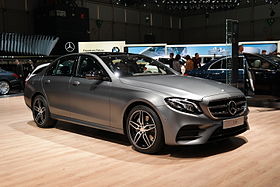Mercedes-Benz E-Class
| Mercedes-Benz E-Class | |
|---|---|

Mercedes-Benz E 200 Avantgarde (W 212, Facelift)
|
|
| Overview | |
| Manufacturer |
Mercedes-Benz Magna Steyr (1996–2009, 4MATIC only) |
| Production | 1993–present |
| Body and chassis | |
| Class | Mid-size luxury / Executive car (E) |
| Layout | Front engine, rear-wheel drive/Four-wheel drive |
| Chronology | |
| Predecessor | Mercedes-Benz W124 (pre-facelift models, 1984–1993) |
| W124 | |
|---|---|
 |
|
| Overview | |
| Production | 1993–1995 |
| Body and chassis | |
| Body style | 4-door sedan 5-door station wagon 2-door coupé 2-door convertible |
| W210 | |
|---|---|
 |
|
| Overview | |
| Production | 1995–2003 |
| Model years | 1996–2002 |
| Body and chassis | |
| Body style | 4-door sedan 5-door station wagon |
| W211 | |
|---|---|
 |
|
| Overview | |
| Production | 2002–2009 |
| Model years | 2003–2009 |
| Body and chassis | |
| Body style | 4-door sedan 5-door station wagon |
| Related | Mercedes-Benz CLS-Class (W219) |
| Mercedes-Benz W212 | |
|---|---|
 |
|
| Overview | |
| Production | 2009–2016 |
| Model years | 2010–2016 |
| Body and chassis | |
| Body style | 4-door sedan 5-door station wagon |
| Layout | Front engine, rear-wheel drive / four-wheel drive (4Matic) |
| Related | Mercedes-Benz W218 |
| Mercedes-Benz C207 | |
|---|---|

Mercedes-Benz E 350 CDI (C207)
|
|
| Overview | |
| Production | 2009–present |
| Model years | 2010–present |
| Body and chassis | |
| Body style | 2-door coupé 2-door convertible |
| Related | Mercedes-Benz C-Class (W204) |
| Mercedes-Benz W213 | |
|---|---|

Mercedes-Benz E 200 (W213)
|
|
| Overview | |
| Production | 2016–present |
| Model years | 2017–present |
| Body and chassis | |
| Body style | 4-door sedan 5-door station wagon 2-door coupe |
The Mercedes-Benz E-Class is a range of executive cars manufactured by German automaker Mercedes-Benz in various engine and body configurations produced since 1993, marketed worldwide across five generations.
Prior to 1993, Mercedes-Benz offered the same category of car under a non-unified naming structure. The E initially stood for Einspritzmotor (German for fuel injection engine); a new feature in volume production vehicles at the time that the E-Class first appeared, with the E as a suffix to the engine nomenclature (e.g. 230 E) in the 1960s. It was not until the launch of the facelifted W124 in 1993 that the E was used as a prefix (i.e., E 220) and the model referred to officially as the E-Class (or E-Klasse). At this time all Mercedes cars used fuel injection and the company felt it was no longer necessary to add this as a distinguishing feature. All generations of the E-Class have offered either rear-wheel drive or Mercedes' 4Matic four-wheel drive system.
Historically, the E-Class is Mercedes-Benz' best-selling model, with more than 13 million sold by 2015. The First E-Klasse series was originally available as four-door sedan, five-door station wagon, 2 door coupe and 2 door convertible. The W212 series in 2009 reintroduced the two-door coupé and two-door convertible. Before that, the Mercedes-Benz CLK-Class (1997 to 2009) design and styling was derived from the E-Class although technically it was based on the mechanical underpinnings of the smaller C-Class. Due to the E-Class's size and durability, it has filled many market segments, from personal cars to frequently serving as taxis in European and Asian countries, as well special-purpose vehicles (e.g. police or ambulance modifications) from the factory.
The first modern midsize Mercedes was the W120 'Ponton' 180 of 1953. Sharing its engineering with the R121 190 SL of 1955, the Ponton was a stylish sedan with a four-cylinder engine. A larger-engined W121 190 appeared in 1958.
...
Wikipedia
